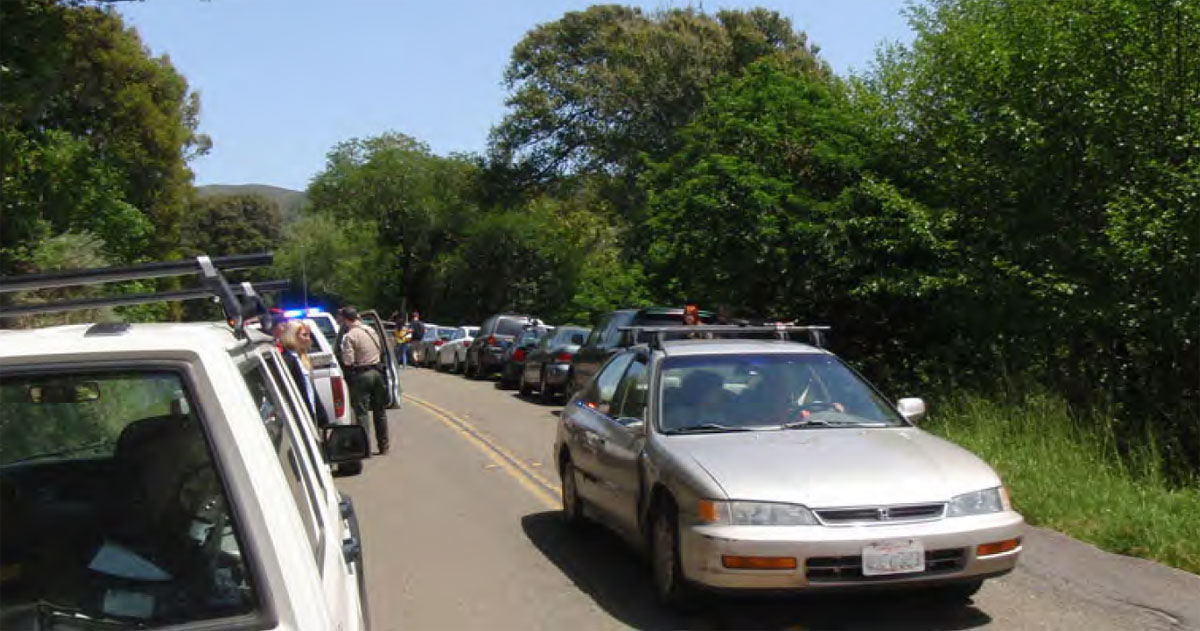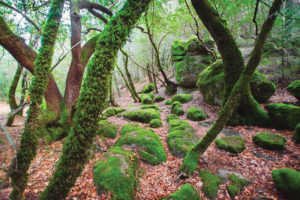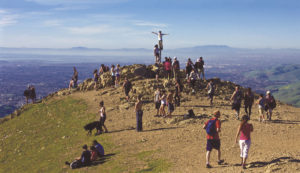f you think about visiting Muir Woods National Monument in the next year, the National Park Service hopes you will keep some version of this old sentiment in mind: if you love something, set it free.
In early 2017 the agency will launch a reservation system meant to cut back on chronic overcrowding in the grove of ancient redwoods below Mount Tamalpais. But until then it’s likely to be more crowded and more difficult than ever to visit one of the only places on Earth where old-growth redwood trees grow an hour away from a major urban area. So the Park Service is asking Bay Area residents concerned about the crowds’ effects on the peace and health of Muir Woods to make a sacrifice in the name of love: stay away. “Muir Woods is so beautiful, it’s so interesting, it’s so special, and it’s so close to the city. It’s on the ‘must-see’ list for every visitor to the Bay Area,” said Muir Woods Site Supervisor Mia Monroe. “And locals love it, too—we come back to the woods again and again for rest and respite. All that means that our little redwood park is a very, very, very popular place.”
Crowding is a problem that has been generations in the making. A 1947 article in the Sausalito News quoted then-Muir Woods custodian Walter Finn lamenting, “Increased use of Muir Woods by the general public has created a serious problem.” The article continues, “so many visitors have been attracted to the area that ferns and other foliage are being trampled down. Later, Finn addressed the county supervisors, stating that “something must be done to limit the number of people who visit the park.”

Just eight miles north of the Golden Gate Bridge, the park sits along a narrow, winding road that climbs from Muir Beach to the Panoramic Highway. Parking lots near the entrance accommodate about 150 cars, and on summer weekends they’re full for most of the day. Hundreds of drivers idle hopefully in the lot or hunt for a spot somewhere along the road. On many days, parked cars line the shoulder for a mile outside of the park entrance, and visitors walk in the lanes or on the steep, sensitive banks of Redwood Creek to reach the woods. “Muir Woods is overrun,” Monroe said. “The roads are congested, it’s hard to find parking, and once they reach the woods themselves, people feel like they have to leave the main trails to get the peace and solitude that they’ve come out here to find.”
In 2003, land management agencies, residents and businesses created a shared vision for the future of the Redwood Creek watershed, concluding that “overcrowding in the parks and general traffic congestion were factors negatively impacting the public’s ability to enjoy the resources.” Since then, the Park Service has tried out various strategies aimed at reducing traffic through Muir Woods, including installing signs on Highway 101 that let visitors know when parking lots are full, implementing a public shuttle on summer weekends, and encouraging carpooling, cycling or hiking into the monument from one of several nearby trailheads.
But the congestion is still getting worse. Annual visits to Muir Woods have climbed at a steady rate of about 1.5 percent per year for the past 15 years, reaching above one million in 2014. Four out of five visitors come by car, and most of the visitors who don’t come by car step off tour buses, whose engines idle in the parking lot while their customers are wandering among the redwoods. Chronic traffic problems have drawn ire from the park’s neighbors, who have to endure the gridlock getting to and from their homes on busy weekends. “It’s primarily a safety concern,” said Kristin Shannon, chair of the Mount Tam Task Force, a coalition of neighborhood and environmental groups from communities that flank the mountain. “On a really busy day, if someone has a heart attack, they just won’t be able to make it to the hospital.”
Protests from the park’s neighbors prevented previous attempts by NPS to expand capacity at Muir Woods. In 2014, when the agency proposed building an overflow parking lot on Panoramic Highway, the Mt. Tam Task Force raised objections and the plan was quickly shelved. Plans for an expanded shuttle stop on Highway 1 in Muir Beach met a similar fate. Shannon said it took prodding by the Marin County Board of Supervisors, especially Supervisor Kate Sears, to galvanize the Park Service into developing its forthcoming reservation system.
For now, though, anyone can visit Muir Woods any time that it’s open, though the Park Service encourages weekday and off-season visits. When the new system launches in 2017, all Muir Woods visitors who park or take a shuttle to the main gate will be required to buy a timed reservation online or over the phone through a third-party concessionaire, and only vehicles with proof of that reservation will be allowed to park in the lots or in limited, designated spots along the shoulder. Reservations will be open-ended, meaning visitors will be able to spend as much time in the park as they please once they arrive. “We want to make Muir Woods available to as many people as possible, but in a smart way,” Monroe said. “It’s like visiting a popular restaurant — you want to be able to talk to your friends, you don’t want to feel jostled or crowded, and you don’t want to worry that they’re trying to get rid of you or give your table away.”
On the busiest days this summer, more than 6,000 people strolled through the park. Rather than cap the number of annual visitors outright, the Park Service hopes that the reservation system will “level off” those peaks by restricting vehicle and shuttle access to permit-holders. The plan aims to keep visitation below about 4,200 people for all but the busiest weekends, and projects 924,400 visitors in the first year of the reservation system. “We want it to still feel welcoming, just less crowded,” Monroe said. “You don’t want to waste your time, and we don’t want you to waste time you should be spending in Muir Woods with parking hassles and lines.”
Critics say it’s not enough, and are angling for steeper reductions in the overall number of people that come to the park. “Things don’t work well when you start going over 700,000 visitors a year,” Shannon said. “The Park Service has come up with this annual target, but they don’t have the science on the actual carrying capacity of Muir Woods to back it up. It’s an arbitrary number.” Shannon called the reservation system a “good start,” but pointed out that it doesn’t directly control the number or flow of visitors to the site. “The reservation system has been presented as a panacea to the long-term management of Muir Woods, but really, it’s just a parking management tool,” she said.
Tom Martell, who ran small, guided tours in Muir Woods for 25 years, said he’d like to see a cap set at a quarter of a million visitors, and those visits be primarily in small, guided groups. “It should be an educational thing,” Martell said. “As it is, people are unsupervised. A lot of these folks, they don’t treat it as if it’s a special thing. Their kids are running around off trails, the traffic is awful. It’s enough to break your heart.”
The reservation system’s goal is to facilitate “an inspiring and contemplative experience,” according to a 25-page environmental assessment of the plan issued by the Park Service. Monroe said she’s optimistic that the learning curve for the public adjusting to the new system will be gentle. Other national parks have seen good results from similar efforts to address the paradox of too many people trying to get away from too many other people by visiting a national park. Summertime visitors to Zion National Park have to leave their cars at the gates and can only travel the park’s main road by shuttle. Well-prepared hikers vie for coveted permits to take the cables route up Half Dome in Yosemite National Park. A third-party vendor manages reservations for the ferry ride to Alcatraz, another site within the Golden Gate National Recreation Area that’s very famous, very fragile, very close to the city, and very popular. “Most World Heritage Sites—from the Louvre to Machu Picchu in Peru—require advanced planning,” Monroe said. “There’s plenty of precedent for a reservation system working well to address some of the problems we’re facing out at Muir Woods.”
The Mount Tam Task Force filed an intent to sue the Park Service last summer, charging that NPS isn’t acting fast enough. And the Marin County Board of Supervisors has approved new parking restrictions on Muir Woods Road that start in the first half of 2016, well before the reservation system is up and running. “That’s when our crisis period begins,” Monroe said. “We’ll still be facing the huge demand for access to Muir Woods, but we won’t have a system in place yet for managing that traffic.”
Another point of contention between the Park Service and critics has been over the ecological value of the reservation system. The plan’s primary focus is improving the visitor experience, not mitigating the ecological effects of a million annual visitors. The Park Service’s environmental assessment concludes that signs of ecological trouble—such as trampling damage to the redwood trees, proliferating unofficial trails, stresses to threatened or endangered species, or an uptick in invasive weeds—have so far been minimal within Muir Woods.
But Martell, a self-described “gadfly,” says he has noticed a change in the woods in the past three decades. “The butterflies are gone, the lichens are gone, the ladybugs are gone, and all the cars are leaking rubber residue and copper oxide which—when it rains—just gets flushed right into the creek,” he said.
The Park Service hasn’t done scientific studies on the effects of visitors on the forest, Monroe said. But she said that indirectly it’s hard to make a case that the forest is suffering from overcrowding. “What I can tell you is otters have returned, coyotes have returned, and spotted owls are nesting,” she said. “Scientists say our forest is healthy. The lichen is abundant—we have seen a resurgence of species that only do well when the air is pure and clean.”
Whether for the sake of the forest, its frustrated neighbors, or its solitude-seeking visitors, the Park Service hopes to limit the number of people who stroll through Muir Woods. Until the reservation system is in place—at least a year from now—the Park Service hopes you’ll look elsewhere for your redwood fix. So I asked Monroe what her favorite forest is that isn’t Muir Woods, and had to scramble to write down the long list of options she rattled off: Portola Redwoods, Big Basin and Purisima Creek in the South Bay, Nathaniel Owings Memorial Grove in Big Sur, Roy’s Redwoods and Steep Ravine in the North Bay, Redwood Regional in the East Bay, Prairie Creek in Humboldt County … we have plenty of options to choose from, none of which shoulder quite the burden that Muir Woods does. “We’re asking people who love Muir Woods and are serious about protecting it to dream about it instead for a while,” Monroe said. “Even though we’re taking all these steps right now to try to get you to stay away, I’m always thinking about: What can we do to get you back? I hope we can welcome you back with open arms some day.”





